-

人教版高中英语必修2Cultural Relics说课稿2篇
Ⅲ. Analysis of the teaching material:The topic of this unit is cultural relics. Students are quite interested in topics about different cultures around the world. This is the second period of the whole unit. As a reading class, the passage mainly talks about the history of the amber room (how it was made, sent as a gift, lost and rebuilt).According to the new national curriculum, when teaching reading, much emphasis should be put on training the students’ reading skills.Ⅳ. Teaching objectives1. Language objectives:1) Students are required to master the key words and phrases occurred in the passage (e.g. amazing, decorate, belong, in return, less than etc.)2) Students are required to learn the attributive clause and acquire the sentence pattern.2. 1) Students are required to describe a certain thing by using the new sentence patterns.2) Students are required to master two kinds of reading skills—skimming and scanning, and learn to use them in their daily reading.3. 1) Students are required to know the history of the amber room.2) Students are required to appreciate cultural relics and understand the importance of protecting them.Ⅴ. Teaching important and difficult points1) the new words, phrases, and sentence pattern in the course of reading.2) Teaching difficult point: Help the students master two kinds of reading skills—skimmingand scanning and learn to apply them in daily use.Ⅵ. Teaching methods:Task-based method & Top-down model Ⅶ. Teaching aids: PPT, pictures, blackboard Ⅷ. Teaching procedure:

部编人教版四年级下册《 短诗三首》说课稿
教学目标1.认识“漫、涛”2个生字,读准“啊”“膝”等音变和易误读字音,会写“繁、漫”等8个 生字,理解“漫灭”“思潮”等词语。2.诵读优秀诗文,注意在诵读过程中体验情感,展开想象,领悟诗文大意。3.初步了解现代诗的一些特点,体会诗歌的情感。重难点:依据教学目标和学生的认知特点,确定本课教学的重难点:体会诗歌的韵味,展开想象,体悟情感,了解现代诗的特点。三、说教法、学法四年级学生在此前已经接触过现代诗,但是对现代诗特点了解相对模糊。课堂教学中通过不同形式的反复朗读,情境创设,补白想象,补充资料等教学策略,通过探究学习,发现现代诗歌的特点:朗朗上口富有节奏,蕴含丰富想象,饱含真挚情感。在评价中激发学生学习诗歌的热情,在赏读中感受诗歌的魅力。进而实现用“繁星”学习现代诗特点、用现代诗特点学习“繁星”诗意诗情的融合统一。
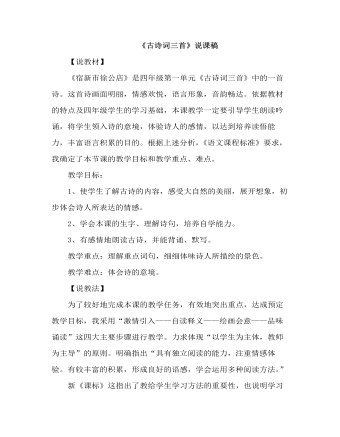
部编人教版四年级下册《古诗词三首》说课稿
教学目标:1、使学生了解古诗的内容,感受大自然的美丽,展开想象,初步体会诗人所表达的情感。2、学会本课的生字、理解诗句,培养自学能力。3、有感情地朗读古诗,并能背诵、默写。教学重点:理解重点词句,细细体味诗人所描绘的景色。教学难点:体会诗的意境。【说教法】为了较好地完成本课的教学任务,有效地突出重点,达成预定教学目标,我采用“激情引入——自读释义——绘画会意——品味诵读”这四大主要步骤进行教学。力求体现“以学生为主体,教师为主导”的原则。明确指出“具有独立阅读的能力,注重情感体验。有较丰富的积累,形成良好的语感,学会运用多种阅读方法。”新《课标》这指出了教给学生学习方法的重要性,也说明学习方法远远比学得的知识重要。因此,我要求学生在学习过程中,充分地读书,充分地交流,充分地参与,充分地合作。主要学习步骤为:自读、交流、质疑、绘画、品读。
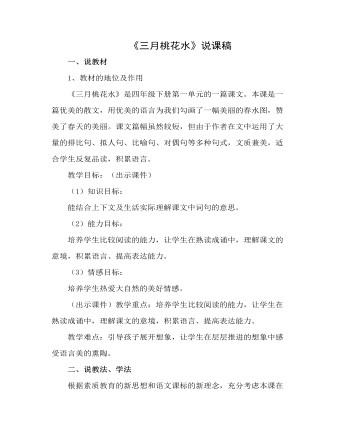
部编人教版四年级下册《三月桃花水》(说课稿)
(3)情感目标:培养学生热爱大自然的美好情感。(出示课件)教学重点:培养学生比较阅读的能力,让学生在熟读成诵中,理解课文的意境,积累语言、提高表达能力。教学难点:引导孩子展开想象,让学生在层层推进的想象中感受语言美的熏陶。二、说教法、学法根据素质教育的新思想和语文课标的新理念,充分考虑本课在教材中的地位和学生的实际,综合“知识与技能”、“过程与方法”、“情感态度和价值观”这三个维度的要求,我遵循“初步感知——整体感知——精读品味——整体回顾”的阅读规律,采用“层进性教学模式”设计教学。以读为主线,以读代讲,以读促表达的教学方法,在朗读中创设情境,理解课文的意境。这节课,我主要教给孩子们边读边悟并及时批注自己阅读感悟的学习方法,再抓住段后的省略号,引导孩子展开想象,让学生在层层推进的想象中受到语言美的熏陶。
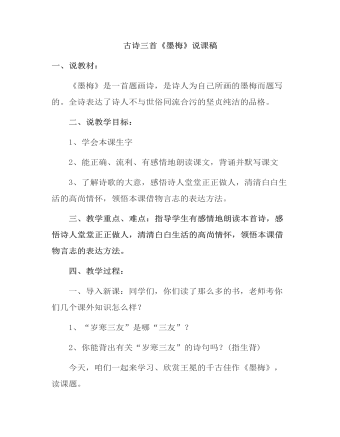
部编人教版四年级下册古诗词三首《墨梅》说课稿(一)
一、说教材:《墨梅》是一首题画诗,是诗人为自己所画的墨梅而题写的。全诗表达了诗人不与世俗同流合污的坚贞纯洁的品格。 二、说教学目标:1、学会本课生字2、能正确、流利、有感情地朗读课文,背诵并默写课文3、了解诗歌的大意,感悟诗人堂堂正正做人,清清白白生活的高尚情怀,领悟本课借物言志的表达方法。三、教学重点、难点:指导学生有感情地朗读本首诗,感悟诗人堂堂正正做人,清清白白生活的高尚情怀,领悟本课借物言志的表达方法。四、教学过程:一、导入新课:同学们,你们读了那么多的书,老师考你们几个课外知识怎么样?1、“岁寒三友”是哪“三友”?2、你能背出有关“岁寒三友”的诗句吗?(指生背)今天,咱们一起来学习、欣赏王冕的千古佳作《墨梅》,读课题。
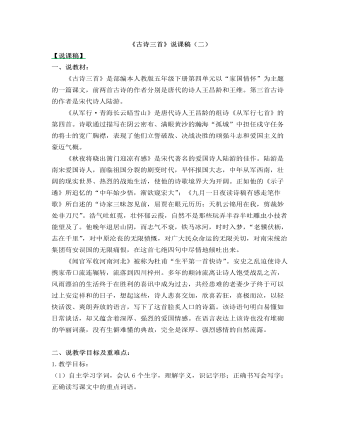
部编人教版五年级下册《古诗三首》说课稿(二)
二、说教学目标及重难点:1.教学目标:(1)自主学习字词,会认6个生字,理解字义,识记字形;正确书写会写字;正确读写课文中的重点词语。(2)有感情地朗读古诗,背诵古诗,默写《从军行》《秋夜将晓出篱门迎凉有感》。(3)借助注释和插图理解古诗的大意,并能用自己的话说出诗句的主要意思。(4)深入理解古诗内容,学会背诵古诗。理解古诗大意,体会作者的思想感情。2.教学重点:自主学习字词,理解字义,识记字形;有感情的朗读、背诵古诗,默写《从军行》和《秋夜将晓出篱门迎凉有感》;借助注释和插图理解古诗的大意,并能用自己的话说出诗句的意思;凭借语言文字注解、图片等,在反复诵读的基础上,想象诗歌所描绘的情景,体会诗人所表达的思想感情,感受诗歌的语言美和内蕴美。
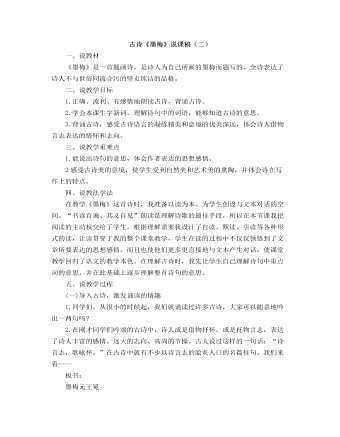
部编人教版四年级下册古诗词三首《墨梅》说课稿(二)
一、说教材《墨梅》是一首题画诗,是诗人为自己所画的墨梅而题写的。全诗表达了诗人不与世俗同流合污的坚贞纯洁的品格。二、说教学目标1.正确、流利、有感情地朗读古诗,背诵古诗。2.学会本课生字新词。理解诗句中的词语,能够知道古诗的意思。3.背诵古诗,感受古诗语言的凝练精美和意境的优美深远,体会诗人借物言志表达的情怀和志向。三、说教学重难点1.能说出诗句的意思,体会作者表达的思想感情。2感受古诗美的意境,使学生受到自然美和艺术美的熏陶,并体会诗在写作上的特点。
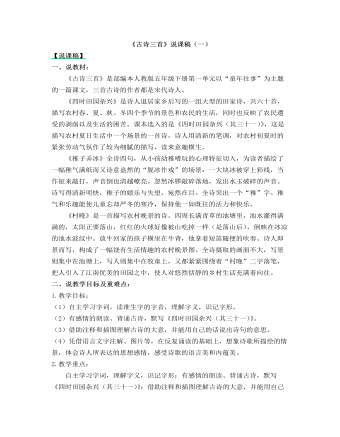
部编人教版五年级下册《古诗三首》说课稿(一)
三、说学情:五年级的学生在古诗学习中已经积累了一定的经验,对文本有独特的阅读体验。课文所描写的情景又都与儿童有关,反映儿童生活,学生也可能有着相似的亲身经历,符合学生的心理,容易引起学生情感的的共鸣,进而在阅读古诗中获得感知,加以模仿,发展想象力,锻炼学生的理解能力和语言表达能力。四、说教法和学法:1.说教法:教学中,设置情景,激发学生认知兴趣,调动学生主动学习的欲望,引导学生主动探究。使学生这一教学主体主动积极地进行语言文字的学习和探究。2.说学法:教学过程体现“以读为本”的新课标理念,教学中,始终让“读”贯穿着整个教学过程。引导学生在读中感受古诗词的优美精湛的语言文字和丰富的人文内涵;在入情入境的读中有所感悟和思考;在读中受到情感的熏陶,获得思想的启迪。
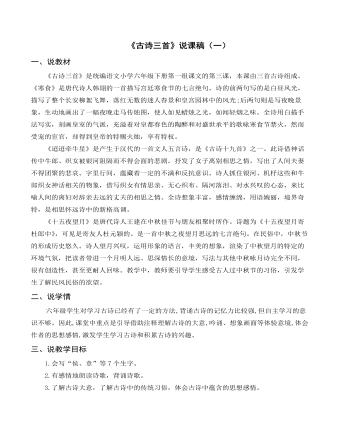
部编人教版六年级下册《古诗三首》说课稿(一)
一、说教材《古诗三首》是统编语文小学六年级下册第一组课文的第三课,本课由三首古诗组成。《寒食》是唐代诗人韩翃的一首描写宫廷寒食节的七言绝句。诗的前两句写的是白昼风光,描写了整个长安柳絮飞舞,落红无数的迷人春景和皇宫园林中的风光;后两句则是写夜晚景象,生动地画出了一幅夜晚走马传烛图,使人如见蜡烛之光,如闻轻烟之味。全诗用白描手法写实,刻画皇室的气派,充溢着对皇都春色的陶醉和对盛世承平的歌咏寒食节禁火,然而受宠的宦官,却得到皇帝的特赐火烛,享有特权。《迢迢牵牛星》是产生于汉代的一首文人五言诗,是《古诗十九首》之一。此诗借神话传中牛郎、织女被银河阻隔而不得会面的悲剧,抒发了女子离别相思之情,写出了人间夫妻不得团聚的悲哀。字里行间,蕴藏着一定的不满和反抗意识。诗人抓住银河、机杼这些和牛郎织女神话相关的物象,借写织女有情思亲、无心织布、隔河落泪、对水兴叹的心态,来比喻人间的离妇对辞亲去远的丈夫的相思之情。全诗想象丰富,感情缠绵,用语婉丽,境界奇特,是相思怀远诗中的新格高调。
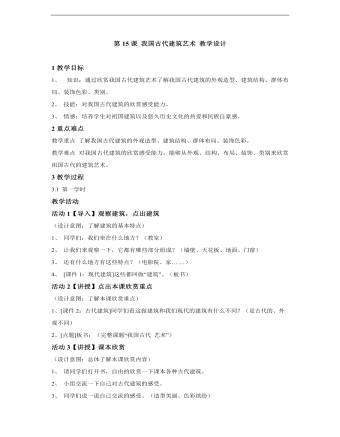
小学美术人教版六年级下册《第15课我国古代建筑艺术》教学设计说课稿
2重点难点教学重点了解我国古代建筑的外观造型、建筑结构、群体布局、装饰色彩。教学难点对我国古代建筑的欣赏感受能力,能够从外观、结构、布局、装饰、类别来欣赏祖国古代的建筑艺术。3教学过程3.1 第一学时教学活动活动1【导入】观察建筑,点出建筑(设计意图:了解建筑的基本特点)1、同学们,我们坐在什么地方?(教室)2、让我们来观察一下,它都有哪些部分组成?(墙壁、天花板、地面、门窗)3、还有什么地方有这些特点?(电影院、家… …)4、 [课件1:现代建筑]这些都叫做“建筑”。(板书)

部编人教版五年级下册《童年的发现》(新版)说课稿
四、说教法和学法:1.说教法:学习这篇课文,要让学生通过自读自悟和讨论交流,了解课文主要内容──“我”发现了什么、是怎么发现的;从中激发学生勤学好问、大胆想象、乐于探究的学习精神;体会心理活动描写对塑造人物形象的重要作用,能真实表达自己的内心感受。2.说学法:在本课的教学中,我主要教给学生学会自主探究,学会自己发现问题和解决问题的方法,学会合作学习,在合作学习中发现和解决更多的问题。引导学生学会抓住重点句段理解课文的方法。五、说教学流程:1.交流揭题,激发兴趣。引导学生回忆交流学过的课文中描写童年生活的片段,由片段交流引出“发现”,由片段交流引出“童年”,由对“童年”的交流引出课题完成“童年的发现”,激发了学生阅读课文的兴趣。2. 紧扣“发现”,初读课文。(1)默读课文,读准字音,读通句子。(2)自学课文生字词,可以用笔在文中圈出来,然后用合适的方法来解决生字词。
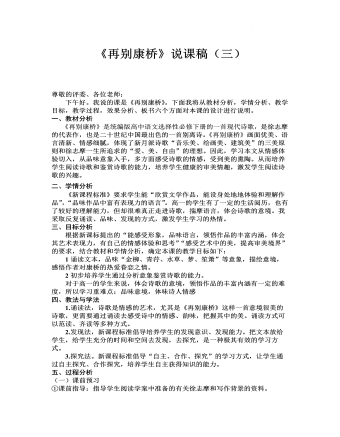
《再别康桥》说课稿(三) 2021-2022学年统编版高中语文选择性必修下册
四、教法与学法1.诵读法,诗歌是情感的艺术,尤其是《再别康桥》这样一首意境很美的诗歌,更需要通过诵读去感受诗中的情感、韵味,把握其中的美。诵读方式可以范读、齐读等多种方式。2.发现法,新课程标准倡导培养学生的发现意识、发现能力。把文本放给学生,给学生充分的时间和空间去发现,去探究,是一种极其有效的学习方式。3.探究法。新课程标准倡导“自主、合作、探究”的学习方式,让学生通过自主探究、合作探究,培养学生自主获得知识的能力。 五、过程分析(一)课前预习①课前指导:指导学生阅读学案中准备的有关徐志摩和写作背景的资料。②指导学生诵读文本,读准字音,读出节奏,体会感情。鉴赏诗歌离不开诗歌意象和有感情的诵读,引导学生边读边思考:诗歌写了什么内容?从哪些句子看出来?勾画出你感受最深的句子。怎样朗读才能从分表达作者的感情?让学生设计一个自己认为最值得探究的问题。让学生设计一个自己认为本文最值得探究的问题。
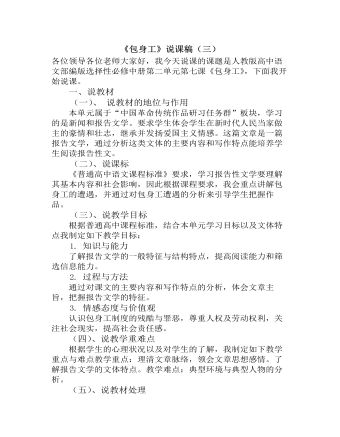
《包身工》说课稿(三) 2021-2022学年统编版高中语文选择性必修中册
一、说教材(一)、 说教材的地位与作用本单元属于“中国革命传统作品研习任务群”板块,学习的是新闻和报告文学。要求学生体会学生在新时代人民当家做主的豪情和壮志,继承并发扬爱国主义情感。这篇文章是一篇报告文学,通过分析这类文体的主要内容和写作特点能培养学生阅读报告性文。(二)、说课标《普通高中语文课程标准》要求,学习报告性文学要理解其基本内容和社会影响,因此根据课程要求,我会重点讲解包身工的遭遇,并通过对包身工遭遇的分析来引导学生把握作品。(三)、说教学目标根据普通高中课程标准,结合本单元学习目标以及文体特点我制定如下教学目标:1. 知识与能力了解报告文学的一般特征与结构特点,提高阅读能力和筛选信息能力。2. 过程与方法通过对课文的主要内容和写作特点的分析,体会文章主旨,把握报告文学的特征。3. 情感态度与价值观认识包身工制度的残酷与罪恶,尊重人权及劳动权利,关注社会现实,提高社会责任感。
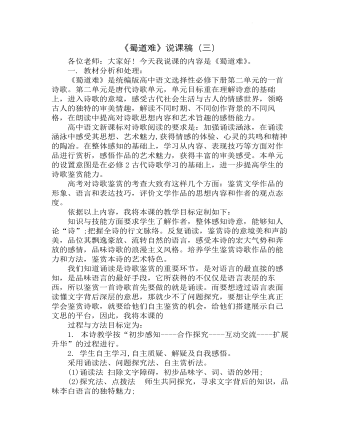
《蜀道难》说课稿(三) 2021-2022学年统编版高中语文选择性必修下册
(3)夸张到极致的技巧: (学生寻找出诗歌中的夸张语句,谈出感受) (4)多样的诗歌意境: 为了表达主观感受与目的的需要,诗歌中构织不同的意境:高峻、宏伟、神奇、凄清、恐怖等各种意境均有描绘,而这些意境又统统表现一个“难”字。 (5)神秘的传说: “五丁开山”“太阳神回车”“子规哀啼”等传说的出现,使全诗笼罩一种神秘气氛,也从另一个角度表现出了一个“难”字。 2、明确诗歌的主旨和情感。 这首诗以咏叹为基调,一叹蜀道之高,二叹蜀道之险,三叹蜀中战祸之烈,而战祸之烈是由于蜀道高险给割据者创造了良好条件的缘故。因此,对军事叛乱的警惕正是诗人的主旨所在。“蜀地不可去,不可居”是其表达的要义。(设计目的在于:1、全面把握诗歌的艺术特色,以便学生写作借鉴,掌握作文的技巧。2、把握诗歌主旨,更深刻理解诗人的情感)

新人教版高中英语必修3Unit 2 Morals and Virtues-Discovering Useful Structure教学设计
1. 表示时间。Hearing these stories, I’m skeptical about the place. = When I heard these stories. . . 2. 表示原因。Not knowing his address, I can’t send this book to him. = Because/Since/As I don’t know his address. . . 3. 表示结果。His father died, leaving him a lot of money. =. . . and left him a lot of money4. 表示条件。Going straight down the road, you will find the department store. = If you go straight down the road. . . 5. 表示让步。Being tired, they went on working. =Although they were tired. . . 6. 表示行为方式、伴随情况或补充说明。He lay on the grass, staring at the sky for a long time. =. . . and stared at the sky for a long time注意:非谓语动词作状语时, 如所提供的动词不能和句子中的主语保持一致, 动词-ing形式必须有自己的逻辑主语, 通常由名词或代词来担任, 这就是独立主格结构。The last bus having gone, we had to walk home. (having gone的逻辑主语是the last bus, 而不是we)Weather permitting, the football match will be played on Friday. (permitting的逻辑主语是time, 而不是the football match)Step 7 Practice1. ________(study) hard, you are sure to get first prize. 2. People use plastic in their daily life, _______(leave) large amounts of waste. 3. ________(work) hard at your lessons, you are to succeed. 4. The old man, ____________(work) abroad for twenty years, is on the way back to his motherland. 5. ______________(finish) his homework, he was playing on the playground. Answers: 1. Studying 2. leaving 3. Working 4.having worked 5. Having finishedStep 8 HomeworkFinish the homework on Page 22.

新人教版高中英语选修2Unit 1 Science and Scientists-Discovering useful structures教学设计
The grammatical structure of this unit is predicative clause. Like object clause and subject clause, predicative clause is one of Nominal Clauses. The leading words of predicative clauses are that, what, how, what, where, as if, because, etc.The design of teaching activities aims to guide students to perceive the structural features of predicative clauses and think about their ideographic functions. Beyond that, students should be guided to use this grammar in the context apporpriately and flexibly.1. Enable the Ss to master the usage of the predicative clauses in this unit.2. Enable the Ss to use the predicative patterns flexibly.3. Train the Ss to apply some skills by doing the relevant exercises.1.Guide students to perceive the structural features of predicative clauses and think about their ideographic functions.2.Strengthen students' ability of using predicative clauses in context, but also cultivate their ability of text analysis and logical reasoning competence.Step1: Underline all the examples in the reading passage, where noun clauses are used as the predicative. Then state their meaning and functions.1) One theory was that bad air caused the disease.2) Another theory was that cholera was caused by an infection from germs in food or water.3) The truth was that the water from the Broad Street had been infected by waste.Sum up the rules of grammar:1. 以上黑体部分在句中作表语。2. 句1、2、3中的that在从句中不作成分,只起连接作用。 Step2: Review the basic components of predicative clauses1.Definition

新人教版高中英语选修2Unit 4 Journey Across a Vast Land教学设计
当孩子们由父母陪同时,他们才被允许进入这个运动场。3.过去分词(短语)作状语时的几种特殊情况(1)过去分词(短语)在句中作时间、条件、原因、让步状语时,相当于对应的时间、条件、原因及让步状语从句。Seen from the top of the mountain (=When it is seen from the top of the mountain), the whole town looks more beautiful.从山顶上看,整个城市看起来更美了。Given ten more minutes (=If we are given ten more minutes), we will finish the work perfectly.如果多给十分钟,我们会完美地完成这项工作。Greatly touched by his words (=Because she was greatly touched by his words), she was full of tears.由于被他的话深深地感动,她满眼泪花。Warned of the storm (=Though they were warned of the storm), the farmers were still working on the farm.尽管被警告了风暴的到来,但农民们仍在农场干活。(2)过去分词(短语)在句中作伴随、方式等状语时,可改为句子的并列谓语或改为并列分句。The teacher came into the room, followed by two students (=and was followed by two students).后面跟着两个学生,老师走进了房间。He spent the whole afternoon, accompanied by his mom(=and was accompanied by his mom).他由母亲陪着度过了一整个下午。

新人教版高中英语选修2Unit 1 Science and Scientists-Learning about Language教学设计
Step 7: complete the discourse according to the grammar rules.Cholera used to be one of the most 1.__________ (fear) diseases in the world. In the early 19th century, _2_________ an outbreak of cholera hit Europe, millions of people died. But neither its cause, 3__________ its cure was understood. A British doctor, John Snow, wanted to solve the problem and he knew that cholera would not be controlled _4_________ its cause was found. In general, there were two contradictory theories 5 __________ explained how cholera spread. The first suggested that bad air caused the disease. The second was that cholera was caused by an _6_________(infect) from germs in food or water. John Snow thought that the second theory was correct but he needed proof. So when another outbreak of cholera hit London in 1854, he began to investigate. Later, with all the evidence he _7_________ (gather), John Snow was able to announce that the pump water carried cholera germs. Therefore, he had the handle of the pump _8_________ (remove) so that it couldn't be used. Through his intervention,the disease was stopped in its tracks. What is more, John Snow found that some companies sold water from the River Thames that __9__________________ (pollute) by raw waste. The people who drank this water were much more likely _10_________ (get) cholera than those who drank pure or boiled water. Through John Snow's efforts, the _11_________ (threaten) of cholera around the world saw a substantial increase. Keys: 1.feared 2.when 3. nor 4.unless 5.that/which 6.infection 7.had gathered 8.removed 9.was polluted 10.to get 11. threat

新人教版高中英语选修2Unit 1 Science and Scientists-Reading and thinking教学设计
Step 5: After learning the text, discuss with your peers about the following questions:1.John Snow believed Idea 2 was right. How did he finally prove it?2. Do you think John Snow would have solved this problem without the map?3. Cholera is a 19th century disease. What disease do you think is similar to cholera today?SARS and Covid-19 because they are both deadly and fatally infectious, have an unknown cause and need serious public health care to solve them urgently.keys:1. John Snow finally proved his idea because he found an outbreak that was clearly related to cholera, collected information and was able to tie cases outside the area to the polluted water.2. No. The map helped John Snow organize his ideas. He was able to identify those households that had had many deaths and check their water-drinking habits. He identified those houses that had had no deaths and surveyed their drinking habits. The evidence clearly pointed to the polluted water being the cause.3. SARS and Covid-19 because they are both deadly and fatally infectious, have an unknown cause and need serious public health care to solve them urgently.Step 6: Consolidate what you have learned by filling in the blanks:John Snow was a well-known _1___ in London in the _2__ century. He wanted to find the _3_____ of cholera in order to help people ___4_____ it. In 1854 when a cholera __5__ London, he began to gather information. He ___6__ on a map ___7___ all the dead people had lived and he found that many people who had ___8____ (drink) the dirty water from the __9____ died. So he decided that the polluted water ___10____ cholera. He suggested that the ___11__ of all water supplies should be _12______ and new methods of dealing with ____13___ water be found. Finally, “King Cholera” was __14_____.Keys: 1. doctor 2. 19th 3.cause 4.infected with 5.hit 6.marked 7.where 8.drunk 9.pump 10.carried 11.source 12.examined 13.polluted 14.defeatedHomework: Retell the text after class and preview its language points

新人教版高中英语选修2Unit 1 Science and Scientists-Using langauge教学设计
This happens because the dish soap molecules have a strong negative charge, and the milk molecules have a strong positive charge. Like magnets, these molecules are attracted to each other, and so they appear to move around on the plate, taking the food coloring with them, making it look like the colors are quickly moving to escape from the soap.Listening text:? Judy: Oh, I'm so sorry that you were ill and couldn't come with us on our field trip. How are you feeling now? Better?? Bill: Much better, thanks. But how was it?? Judy: Wonderful! I especially liked an area of the museum called Light Games.it was really cool. They had a hall of mirrors where I could see myself reflected thousands of times!? Bill: A hall of mirrors can be a lot of fun. What else did they have?? Judy: Well, they had an experiment where we looked at a blue screen for a while, and then suddenly we could see tiny bright lights moving around on it. You'll never guess what those bright lights were!? Bill: Come on, tell me!? Judy: They were our own blood cells. For some reason, our eyes play tricks on us when we look at a blue screen, and we can see our own blood cells moving around like little lights! But there was another thing I liked better. I stood in front of a white light, and it cast different shadows of me in every color of the rainbow!? Bill: Oh, I wish I had been there. Tell me more!? Judy: Well, they had another area for sound. They had a giant piano keyboard that you could use your feet to play. But then, instead of playing the sounds of a piano, it played the voices of classical singers! Then they had a giant dish, and when you spoke into it, it reflected the sound back and made it louder. You could use it to speak in a whisper to someone 17 meters away.? Bill: It all sounds so cool. I wish I could have gone with you? Judy: I know, but we can go together this weekend. I'd love to go there again!? Bill: That sounds like a great idea!

